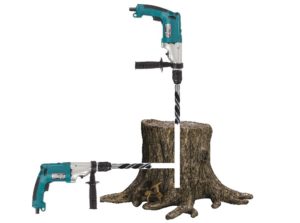
Once you get rid of the old tree, you will remember it for a long time. And it's not even about sentimental feelings ... No matter how hard you try to cut closer to the roots, the stump will remain anyway. High... Low... But he will.
If it does not cause inconvenience to you, you can simply forget about it. In 5-10-20 years, it will rot on its own. And if you need this place for planting some new plants ... or just spoils the view ... So you have to remove it.
Uprooting is, of course, the most effective way. But it requires so much physical effort that sometimes you think: “Yes, and ... with him!”
However, not everything is so bad. There are a couple of ways to remove a stump without uprooting. We will now consider them in detail.
Method number 1 Removing a stump without uprooting
You will need a drill with a drill with a diameter of at least 20mm. Drill length = stump height (ideally).
You need to drill two holes. The first is vertically in the center of the stump. The second is horizontal, closer to the ground. The horizontal hole must intersect with the vertical one. This is an important condition!
Now you will need a cotton cloth and a glass of kerosene or liquid to light a fire (gasoline should not be used - it will quickly burn out, and at the moment of ignition it may “gasp”).
Impregnate a strip of fabric with combustible. Lay the fabric in a vertical hole, add 100 grams of fuel and set it on fire.
As you already understood, a horizontal hole is needed for air to flow into the combustion cavity. If the stump is more than a year old, one tab of fabric with fuel will be enough. The tree will start to burn on its own pretty quickly. This method is more suitable for old stumps.
If the stump is fresh and the wood is damp, you will have to make such a bookmark several times. But! For safety reasons, you need to wait until the previous tab is completely burned out.
This venture should not be undertaken if:
- there are buildings near the stump
- flammable materials are stored near the stump
- next to a gas pipeline
- there is no way to control the combustion process
- in strong wind
The stump will smolder for a very long time, so fire safety measures must be taken:
- prepare water containers, fire extinguishers
- protect the stump with non-combustible shields
Method number 2 Stump removal without uprooting
Also, as in the previous method, you will need a drill and a drill. From the end of the stump, you need to drill a few holes.
One of the following substances is poured into the formed cavities:
- ammonium or potassium nitrate
- urea
- Salt
- iron or copper sulfate.
A small amount of water is poured into the holes. The holes must be closed with a clay plug or a wooden chopstick, cover the stump with a plastic bag and secure it with a rope. Forget about the stump for 6-12 months. After this time, the stump will become rotten and can be easily broken with a sledgehammer or axe.
If you poured saltpeter into the holes, remember that in this way you not only accelerated the process of wood decomposition, but also significantly increased its flammability. A small fire source will be enough to make the stump blaze like a match.
If there is a building, gas pipeline, or other flammable material near the stump, discard the idea of burning the stump. Just break it, and remove the remnants of the wood from the site.
If you do not plan to burn the stump, it is better to use salt or vitriol.
When using any of the above reagents, it is worth remembering that the soil within a radius of 3-5 meters from the stump will be oversaturated with the substance that you apply. This will not have the most beneficial effect on the growth of plants in the surrounding area, as well as on the vital activity of microorganisms in the soil. Soil fertility will be restored gradually - up to 5-10 years.
The optimal time of year for chemical treatment of the stump is late autumn.